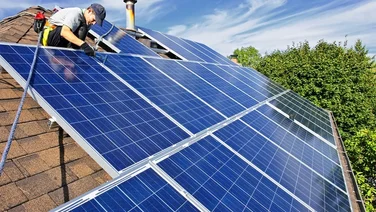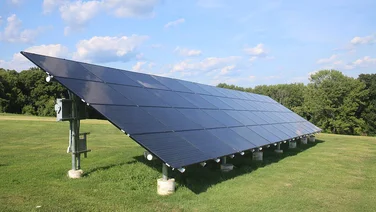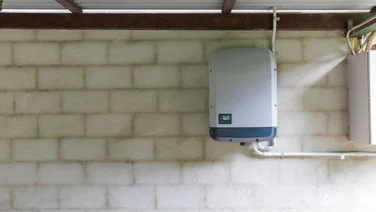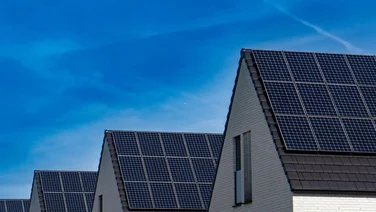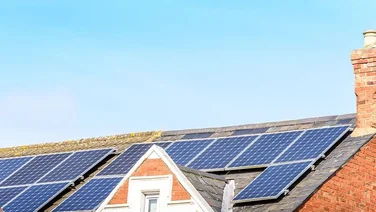- What are solar panel fences?
- Do solar panel fences actually work?
- What are the pros and cons of solar panel fencing?
- How much do solar panel fences cost?
- Is your home suitable for a solar panel fence?
- How are solar panel fences installed?
- Do you need planning permission for a solar panel fence?
- Are solar panel fences worth it?
- Summary
- Solar panel fences: FAQs
- Solar panel fences can be an alternative to roof- or ground-mounted panels
- They are usually installed in agricultural or industrial settings
- Solar panel fences need to be in unobstructed, direct sunlight to generate power

The solar energy industry has grown rapidly over the past couple of decades, with new and more efficient technology becoming more readily available all the time. Because of this, solar panels are being found in a wider range of locations, including fencing.
Solar panel fencing is a less well-known form of renewable energy production, but is becoming an increasingly popular way to save money on electricity bills. In this article, we will look at how solar panel fencing works, the costs involved and whether it’s worth having it installed.
If you’re interested in finding out how much it would cost to install solar panels on your home, complete our free web form to find out.
Where do you want to install solar panels?
Get startedWhat are solar panel fences?
A solar panel fence is, quite literally, an outdoor fence made of solar panels. It provides two purposes:
- surrounding and separating private properties or land
- producing renewable solar energy.
Solar panel fences can be installed in a range of locations, including residential gardens, agricultural land, or industrial and commercial properties. They are similar, but not the same, as ground mounted solar panels.
Do solar panel fences actually work?
The efficiency of a solar panel fence depends largely on its location. As the solar panels are positioned vertically in order to be used as fencing, they are not always at an ideal angle for sun exposure. However, this can be combated by the installation of bifacial panels. These panels are made of monocrystalline cells and are considered to be 30% more effective than mono-facing panels, as they can absorb sunlight from both sides.
A study completed by researchers at the German Leipzig University of Applied Sciences found that vertical bifacial solar panels in an east-west facing direction are most effective at producing solar electricity.
A good example of a solar panel fence working well in action is Foran’s Farm, located in southeast Ireland. The farm’s solar panel fence was installed in 2019. In 2020, the fence generated a total of 27.5 MWh of electricity, supplying half of the farm’s electricity consumption for the year. The landowner expects to recoup his investment in the fence within five years through his energy savings.
Where do you want to install solar panels?
Get startedWhat are the pros and cons of solar panel fencing?
- Reduction in energy bills, long-term savings for residents
- Reduction in a property or business’s carbon footprint
- A more durable and longer lasting option in comparison to regular fencing options
- A good alternative for those who are unable to install rooftop panels
- Beneficial for the agricultural industry, as panels can be incorporated with electrical fences to both produce solar power and keep livestock and property secure
- Solar panels that are mounted in the ground are easier to maintain and clean compared to roof-mounted solar panels
- High maintenance compared to other fence materials such as wood, as panels require regular cleaning to keep their efficiency
- Can be expensive to purchase, install, and maintain in comparison to more common fencing options. This is especially true when in an agricultural setting
- Locations with long winters, little sun, or shaded areas are unsuitable for these fences as sun exposure is necessary for their effectiveness
- Solar panel fences are vertical, so they are more likely to fall under shade from things such as trees or other properties
- Solar panel fences often have gaps in between panels or are partially transparent. This is generally unsuitable for residential homes as the purpose of fencing is to create a privacy screen

How much do solar panel fences cost?
The upfront investment cost for a solar panel fence is generally higher than rooftop solar, but costs can sometimes be recuperated quicker from a fence. Solar panel fencing costs just under double the investment required for a regular aluminium fence. Please note, the below figures do not include the cost of installation.
Length of fence (m) | Approximate cost of panels (excluding VAT) |
|---|---|
5 | £1,350 |
10 | £2,500 |
25 | £6,500 |
50 | £13,100 |
Is your home suitable for a solar panel fence?
The answer to this question depends on the location and length of the fence. Fences are generally only considered profitable once they are over 10m in length.
An east-facing panel fence would be at a preferable angle for sun exposure in the morning for those in the UK. If the panels are bifacial, this means there will be further sun exposure whilst the sun sets in the west.
However, if the fence is often in the shade due to obstructions it is unlikely to be very efficient at generating electricity.
How are solar panel fences installed?
Solar panels are installed vertically in a uniform manner, similarly to a stereotypical wooden or metal fence. They can be installed via posts piled directly into the ground, or on top of a wall.
Agricultural solar panel fences have a more heavy-duty installation process. The solar panels are attached to a fencing post via a bracket. These fences are designed to be robust for security reasons in order to protect livestock. However, in residential examples of solar panel fencing, installation of the panels tends to be simpler.
Green Akku, a German-based solar panel supplier, provides solar panel fencing kits that can mount to pre-existing fences. These kits include PV modules, micro-inverters and mounting material. Green Akku says that the installation process of these panels can be done by the homeowner and only takes five minutes.
Do you need planning permission for a solar panel fence?
In the majority of cases, the installation of solar panel fencing on private property in place of an existing fence does not require planning permission.
However, you would need to apply for planning permission if you are erecting a fence that is over 1 metre high and is adjacent to a road used by vehicles, or over two metres high elsewhere.
If the fence is directly next to another property, it is also a good idea to seek your neighbour’s permission before erecting a solar panel fence.
Are solar panel fences worth it?
Solar panel fencing is a good alternative to consider for those who cannot use rooftop solar, or to be used alongside this.
However, there are a few considerations. Firstly, the fence location needs to be in adequate sunlight and facing the correct orientation (ideally east-west). The fence needs to be long enough to make enough electricity to pay back your investment (over 10m). You also need to consider the appearance of the solar panel fence, and the fact that it is unlikely to give 100% privacy to your land.
If you do decide to install a bifacial solar panel fence, there is a chance that your investment is repaid quicker than with a rooftop solar installation.
Summary
Solar panel fencing is a relatively uncommon way of producing renewable energy, although it is a good solution for farmers to cordon off fields and protect livestock. It very much depends on the orientation of the boundary and space available as to whether solar panel fencing is a good investment.
Fill in our short form to receive an instant free quote for installing solar panels on your property.
Solar panel fences: FAQs
Can solar panels be used as a fence?
Yes, solar panels can be used as a fence! Solar panels are becoming increasingly available as the idea of a green home is popularised. As a result, they are popping up in a range of different places including on roofs, sheds, in the ground, and as fences.
There are a few ways you can install solar panels on a fence, with the most obvious being through a professional solar installation company. DIY mounting systems have emerged in the market for those looking for a more casual installation, where solar panels are hooked on to an existing fence.
What are the disadvantages of a solar fence?
As solar panel fences have the panels placed in a vertical manner, they are not at the most favourable angle for sun exposure in comparison to roof or ground mounted panels. They are also more prone to shadows made by buildings or trees. This will infringe on the efficiency of the solar panels and will affect their power output.
A further disadvantage to consider for those who want a solar panel fence for their home is that these fences often have gaps in between the panels, or they are transparent. As fences in residential areas are usually used for privacy reasons, this is counteractive.
Do you need permission to put solar panels in your garden?
In a majority of cases, the installation of solar panels on private property does not require planning permission as it is usually considered as a permitted development.
However, there are exceptions to this. Any ground-mounted solar system that exceeds nine square metres will need approved planning permission. It is estimated that 10 panels are needed to power a three-bedroom house, so a majority of homes would need planning permission if they are planning to power their home via a ground-mounted system.
In regards to a solar panel fence, planning permission is usually not required if the fence is under two metres tall in any given location on your property, but if the fence is over two metres, or on a road where vehicles are parked and is over one metre tall, this will require planning permission.
How big of a solar panel do I need for a fence charger?
Electric fences are traditionally powered by lead-acid batteries, however, more recently, solar powered electric fences have surged in popularity, especially in agricultural settings. The usage of a solar panel in this setting is easier to maintain as no recharging is required and it is environmentally friendly.
The size of the solar panel needed to power an electric fence depends on the length of the fence. As a rough rule, one five watt panel is required to electrify a five kilometre long fence. A single five watt panel is usually about 25cm by 20cm in size.


